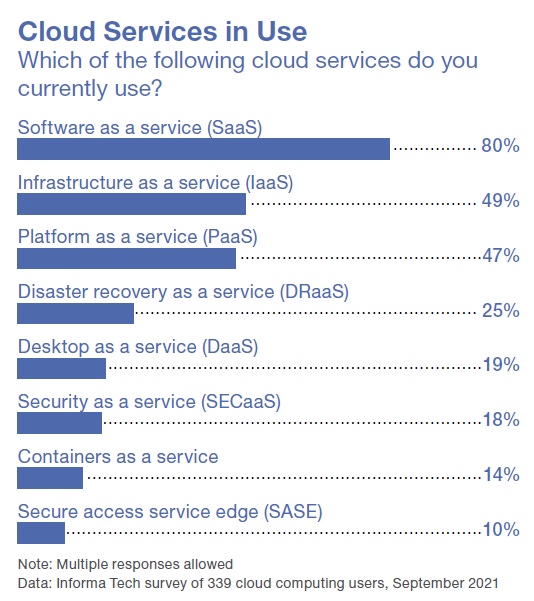
News, news analysis, and commentary on the latest trends in cybersecurity technology.
Half of the IT professionals surveyed who use cloud services also employ infrastructure-as-a-service and platform-as-a-service.

The majority of respondents in a new survey on cloud adoption say they use software-as-a-service (SaaS). Eight in 10 (80%) IT professionals at organizations that employ cloud computing have implemented SaaS.
That's according to "State of the Cloud: A Security Perspective," a report from Dark Reading released in March. The research surveyed decision-makers with IT job titles at organizations that use cloud services. Those organizations include companies of all sizes from a variety of industries, including technology, healthcare, financial services, manufacturing, and education.
The overall picture from the survey is one of a robust remote workforce environment. While SaaS was by far the most widely embraced cloud application, almost half of respondents also reported using infrastructure-as-a-service (49%) and platform-as-a-service (47%). Other everyday work solutions were rarer, including desktop-as-a-service (19%) and containers-as-a-service (14%).
One of the obstacles to implementing cloud computing more widely is concerns about security, the main focus of this report. Many respondents say they already use cloud tools to secure their data and networks. One-quarter (25%) of respondents use disaster-recovery-as-a-service to help bounce back from cyberattacks and natural disasters. Almost one in five (18%) implement security-as-a-service. Only 10% of cloud users run secure access service edge (SASE) defense, however, which means that area is still wide open for competition.
For more data and insights, download the full report.
About the Author(s)
You May Also Like
The fuel in the new AI race: Data
April 23, 2024Securing Code in the Age of AI
April 24, 2024Beyond Spam Filters and Firewalls: Preventing Business Email Compromises in the Modern Enterprise
April 30, 2024Key Findings from the State of AppSec Report 2024
May 7, 2024Is AI Identifying Threats to Your Network?
May 14, 2024
Black Hat USA - August 3-8 - Learn More
August 3, 2024Cybersecurity's Hottest New Technologies: What You Need To Know
March 21, 2024

